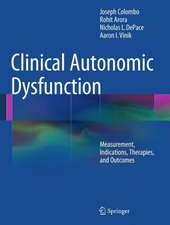A Solution to the Riddle Dyslexia
Autor H.N. Levinsonen Limba Engleză Paperback – 13 apr 2012
Preț: 385.14 lei
Nou
Puncte Express: 578
Preț estimativ în valută:
73.74€ • 76.79$ • 61.18£
73.74€ • 76.79$ • 61.18£
Carte tipărită la comandă
Livrare economică 10-17 februarie
Preluare comenzi: 021 569.72.76
Specificații
ISBN-13: 9781461397762
ISBN-10: 1461397766
Pagini: 424
Ilustrații: XVI, 408 p. 52 illus.
Dimensiuni: 156 x 244 x 22 mm
Ediția:Softcover reprint of the original 1st ed. 1980
Editura: Springer
Colecția Springer
Locul publicării:New York, NY, United States
ISBN-10: 1461397766
Pagini: 424
Ilustrații: XVI, 408 p. 52 illus.
Dimensiuni: 156 x 244 x 22 mm
Ediția:Softcover reprint of the original 1st ed. 1980
Editura: Springer
Colecția Springer
Locul publicării:New York, NY, United States
Public țintă
ResearchCuprins
1 The Riddle Dyslexia and a Solution: An Introductory Sketch.- Historically Rooted Assumptions.- The Diagnostic Void in Dyslexia.- Psychogenic Reflections and Conceptualizations.- The Cortical Physiologic Hypotheses.- Pre-solution Questions and Speculations.- A Solution.- 2 The Spectrum and Panorama of Dyslexia: The Retrospective Study.- The Nuclear Symptomatic Complex in Dyslexia.- Psychogenic and Neurophysiologic Correlations.- The Circular Logic in Dyslexic Research.- Positive Cerebellar-Vestibular Correlations.- The Retrospective Study (N = 1).- Conclusion.- 3 Neurophysiologic and Etiologic Correlations in Dyslexia: The Prospective Study.- Sample.- Frequency Distribution of Cerebellar-Vestibular, Cortical, and Nonlocalizing CNS Findings.- A Quantitative Analysis of the Nuclear Symptomatic Complex in Dyslexia.- Etiologic Considerations and Correlations.- Summary.- 4 A Cerebellar-Vestibular Hypothesis of the Dyslexic Reading Disorder.- The Role of the Cerebellar-Vestibular Circuits in Ocular Fixation, Tracking, and Processing.- A Clinical Exception Highlights the Cerebellar-Vestibular Rule.- Summary.- Addendum.- 5 Validation of the Dyslexic Reading Hypthothesis: The Staten Island Study.- Theoretical Considerations.- Methodology.- Statistical Methods and Analysis.- Proof of a Subclinical Nystagmus in Dyslexia.- Summary.- Addendum.- 6 Blurring-Speed Distribution in a Kindergarten Population: The Queens Study.- Variations in the Blurring-Speed Methodology—Queens Versus Staten Island Studies.- Methodology and Procedure.- Statistical Data Analysis.- Reliability and Unreliability of Blurring-Speed Data.- Summary.- 7 Compensatory Tracking and Reading Scores in Dyslexia.- Compensatory Tracking in Dyslexia.- Symptomatic Fluctuations in Dyslexia.- Reading Scores andDyslexia.- The Fallacy of Reading-Score-Dependent Definitions of Dyslexia.- The Statistical Rule and Its Exceptions Define Dysmetric Dyslexia.- 8 The Clinical Blurring-Speed Study.- Sample.- Methodology.- Statistical Overview.- Statistical Analysis and Results.- Summary.- 9 Ocular-Motor Tracking Patterns in Dyslexic and Normal Individuals.- Initial Attempt at Classification.- A Second Attempt at Classification.- A Third Attempt at Classification.- Practical Therapeutic Applications.- Summary.- 10 Clinically and Theoretically Derived Cerebellar Functions.- The Cerebellum as Dynamic Sensory-Motor Foreground/Background Filter.- Speculations on the Role of the Cerebellum in Modulating Conscious and Nonconscious Perception.- A New Theory of Motion-Sickness Mechanisms.- 11 Anti-Motion Sickness Medications in Dyslexia.- Sample and Methodology.- Quantitative and Qualitative Results.- Electronystagmographic and Blurring-Speed Pharmacologic Correlations.- Central Versus Peripheral Processing Mechanisms.- “If the Facts Do Not Fit the Theory, Then the Facts Are Wrong”.- A Methodologic Explanation.- Summary.- 12 The Cerebellar-Vestibular Role in Phobias and Related Mental Events.- Methodology and Results.- The Traditional Psychoanalytic View of Phobias, Conversion Hysteria, and Anxiety Neuroses.- Clinical Neurodynamics Versus Single Neuron Potentials.- Symbolic Representations of Somatic Dysfunction.- Emotional and Behavioral Symptoms of Cerebellar-Vestibular Dysfunction.- Summary of Neurodynamic Hypotheses.- The Foreground Content of a Qualitative Dyslexic Case Study.- Electromagnetic, Somatic, and Mental Correlations and Transformations.- Summary.- 13 Criticism and Its Analysis.- Background to the Orton Society Meeting of 1975.- The Orton Society Meeting.- Resistance Forcesin Neurophysiology Research in Dyslexia.- Summary.- 14 A Cosmic Field Theory of Mind.- Mind’s Data Base and Its Analysis.- Biological and Clinical Observations.- An Attempt at Scientific and Religious Integration.- Summary.- Postscript.- 15 A Summary in Cosmic Perspective.- Appendix A. Joan’s Case History: Independent Ophthalmologic, Psycho-Educational, and Optometric Evaluations.- Appendix B. Verbatim “Blind” Cerebellar Dyslexic Data in 22 Dyslexic Children.- Appendix C. Retrospective Qualitative Analysis of Six Complete “Blind” Neurologic Reports.- Appendix D. Caloric Vestibular Stimulation and the Electronystagmographic Methodology.- Appendix E. Dyslexia and So-Called Normal Neurologic Examinations.- Appendix F. Glossary.- References.










